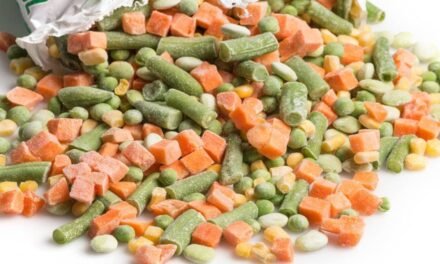The global expansion of Indian food products, with diverse variants tailored to local tastes now found on retail shelves in Europe and America. Rajat K Baisya explores examples of such changes in traditional food products, highlighting the improvements in day-to-day products, including innovative variants of frozen rotis.
Indian food products are now available in markets around the world. Based on the basic Indian food recipes, many product variants and formulations to suit local tastes and preferences are seen on retail shelves in Europe and America. Earlier, we have seen that importer from other countries, including Europe, America, and Japan, would bring expansion of Indian processed foods like marine products, meat and poultry, spices and condiments, and even tea and other plant-based foods and cereals at a price and would resort to repackaging the same into different pack sizes and configuration and would brand them in their own countries and sell at much higher prices as a local brand or even international brand.
Evolution of Product Variants and Formulations
Indian manufacturer-exporters and marketers in those transactions would get small margins of around 10%. And major margins of profit are retained by these importers in their countries. However, the model evolved to get those products manufactured in India itself, and only pricing decisions and declarations were made abroad. With the advent of global supply chain management practices and other regulatory guidelines, including environmental, social, and governance (ESG) principles and traceability requirements, and also with new technologies, business models are rapidly changing.

Innovations in Traditional Indian Food Products
Businesses are struggling to reduce costs to be competitive through cost reduction programs and also through efficiency and effectiveness of global Supply Chain Management initiatives, and, more importantly, through innovations in business processes through technology as well as process improvement activities. We now even see that traditional food product lines and processed food products are going through changes to offer products and their variants for all sections and categories of customers. In this issue of PFI, I will cover a few such examples. Increasingly, products are seen to include some services that consumers hitherto were doing at their ends.
Diverse Offerings in Day-to-Day Food Products
Day-to-day use products, including staples, are also undergoing changes and improvements. Earlier, we had pre-baked chappatis of all forms and types in plastic packs to be heated and served. It was, in addition to frozen chapatis, which has a longer shelf life but is also a little costlier to be heated in a microwave oven and served. But now we can see that innovations are happening even in product categories like chappati (Roti). We can get variants of various sizes of Frozen roti with 50% vegetable content, like carrot or beetroot. These are sold from cold cabinets as chapatis with added nutrition and are now widely distributed in the market. They also look very attractive in red, yellow, and green colours and taste good. People can make vegetable mutton or chicken rolls in these chappatis as a quick meal during lunch or dinner.
The meat, vegetable, and chicken fillers are also available in pre-cooked, ready-to-use, frozen form to be used, so one can just put those fillers to make the roll to be heated to eat. This can avoid making yet another vegetable dish, and busy executives and bachelors find that useful and less time-consuming and still can get the satisfaction of having some vegetables.
ALSO READ
- PM Modi Inaugurated World Food India 2025
- JBT Marel Opens GPC in India to Strengthen Food Processing Innovation
- PET Recyclers Urge Immediate Enforcement of Recycled PET Mandate
- Japanese Scientists Develop Biodegradable Plastic Alternative Using Bacteria
- Yale Breakthrough Turns Plastic Waste into Fuel Without Catalysts
Growth in Vegan and Specialty Food Categories
Those who are health conscious can make rolls with some vegetables inside them, including onions, tomatoes, and leafy vegetables, and those are also available in the market as ready to eat and use. And in addition, one can get all kinds of salads. The salads again are available in many variants; one simple salad that is selling is cut vegetables, including leafy vegetables like lettuce and cucumber, tomato, and onion, which are the normal ingredients that go into the salad. But you also get salad for two or more persons.
There are businesses for supplying salad freshly made using fresh vegetables and some will claim that vegetables are from their own garden and organic. Salads are delivered at home with salad dressings in a small cup to be used according to taste.
Besides, you get salads with various types of salad dressings. You will be amazed to see the types of salad dressing and mayonnaise variations and colours, including spices that are selling in various pack sizes and combinations and brands in the market. Even cutting vegetables, meats, and fish at home is also being taken away from the consumers and included in the product itself.
Meeting Diverse Consumer Needs and Preferences
We get frozen French fries in the market, and this has been there for a long time. We now also get air-fried French fries, oil-fried French fries, crispy French fries, and double-fried French fries – all for different taste preferences and oil contents. This trend is visible in all product categories. Take the case of Dahi. Earlier, we had normal dahi and probiotic dahi; now, you have zero percent fat dahi, Greek dahi, flavored dahi, and high-fat content dahi containing 10% fat. It is so tasty that you would love to have it with fresh fruits.
Specialized Dairy and Bread Variants
I have discussed earlier the milk category and the options that are available. Oat milk will taste so good that you will start liking it and will switch over to it from regular milk. In restaurants and coffee shops, people ask for their cappuccino or latte coffee with oats milk, which costs more than normal milk variants. Now, take the case of butter. Butter with varied percentages of butter fat is introduced in the market. Butter normally needs to be kept inside the fridge, which makes butter a little hard and a little difficult to spread on the bread.
Now, a new butter has been introduced in the market that does not get hardened even when kept inside the refrigerator for days or weeks. When you bring that out, its application is so smooth and easy that the consumer likes it and is delighted. You can buy it straightaway from the market, use it as a bread spread, and experience the smooth application on the bread’s surface. Like this, every category of foods is seen to have multiple choices and variations with different kinds of ingredients to make different kinds of claims. One will be surprised to see the number of variants and options on daily bread that are now available in the market. On seed itself in bread, there are numerous options. Flex seed is considered a cholesterol-reducing ingredient. So, you get bread with flax seeds.

Convenience and Options Across Food Categories
Convenience is another criterion marketers are making use of Innovations have even invaded food like eggs. The exterior surface of the egg is used to stamp the egg for making various claims. Egg yolk and egg white have different nutritional compositions. Consumers are aware that egg yolk has high cholesterol content, which limits the consumption and intake of eggs. Youngsters are very health conscious nowadays. They will take four eggs either as boiled or omelets in their breakfast or after gym but without egg yolks, which they will not take more than one to control cholesterol levels in the blood.
Seeing this trend, new products have been introduced. In the market, you can now get pasteurized egg white with a long shelf life in container packs of various sizes. Earlier, consumers were wasting egg yolk by discarding it and retaining only egg white for egg preparations like omelets, fried eggs, scrambled eggs, or pouches. Now, they can take one egg with yolk and the remaining egg white to make large omelets or other egg preparations that they like. They can also make egg preparations only with egg white without any yolk. You just pour pasteurized egg white from the bottle or carton into the pan, and it gets cooked. You can also make that without any oil. In every category, we can see innovations.
Competition and Brand Positioning Strategies
In each and every product category, there are too many brands. Competition is increasing, and all new players are looking at the market and customer segments to create their own brand positioning platforms to differentiate their products from the others available in the market. As such, there is an explosion of product types, variants, and options that marketers are creating to attract their targeted consumer segments to create a niche for themselves.
In some of the food categories, like vegan foods, the growth is just phenomenal. For every meat and poultry as well as fish preparation, you get vegan options on the retail shelf, and shelf size is becoming bigger and bigger. In India, ITC has taken a big initiative in vegan foods, and they are expected to reap the harvest in this category, taking the lead over others. Because there are low-cost business models which marketers can try and test without incurring huge downside costs, innovations in processed foods are happening at an accelerated pace. For every customer, there is an option available in every food category for taking care of health, nutrition, and medical conditions, if any.
*The author is the chairman of Strategic Consulting Group and served as Professor and Head of the Department of Management Studies, IIT Delhi, India.
















